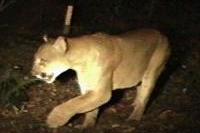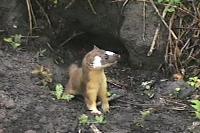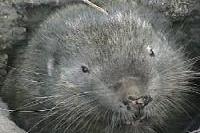For the last six years, still cameras triggered
by active infrared sensors have candidly captured wildlife at Point Reyes National
Seashore. Using unbaited stations along wildlife trails and at mountain beaver burrows,
scientists have acquired 13,000 identifiable photographs of 58 species of wildlife,
including 26 species of mammals and 30 species of birds. With these data the scientists
have answered questions about habitat preference; diurnal and seasonal activity;
distribution of nonnative species; and the recovery of medium-sized mammals from a
13,000-acre fire. They have also used video cameras triggered by multiple passive
infrared sensors to obtain more detailed data on behavior of mountain beaver, spotted
skunks, long-tailed weasels, bobcats, and mountain lions.
|
|
To view the videos, click on an animal below. You will need to download the free Real Player plug-in
from Real.com.
|
| |

|
Mountain lions are only rarely seen at Point Reyes, but they are resident within the park year round.
No one actually knows how many lions inhabit the 71,000 acre park, but based on home range estimates
made elsewhere, it is likely that 4-8 lions live the area. Bobcats are common in the Point Reyes
area and large individuals are sometimes confused with lions. If you see what you think might be a
mountain lion, look for a long tail that could easily touch the ground.
|
| |

|
Long-tailed weasels are uncommon residents of the coastal scrub community at Point Reyes National
Seashore. They feed primarily on rodents. The video shows a group of young weasels as they play
at the entrance to a mountain beaver burrow. Weasels are only one of many species of wildlife that
utilize the burrows dug by mountain beavers. Others include spotted skunks, mice, and rabbits.
|
| |

|
Mountain beavers are nocturnal creatures that are almost never seen. They are not a true beaver,
but rather a muskrat-sized animal that lives in underground burrows. Mountain beaver colonies are
most common in dense thickets of nettles, blackberry, poison oak, and coyote brush. These animals
feed on a wide variety of plant material, including all four plants noted above. Mountain beavers
have primitive, inefficient kidneys and hence mountain beavers must drink 1/3 of their body weight
in water every day. The mountain beaver is unusual in being one of the few mammals to shed tears
(milky white in color), and in being the host to the world's larges flea (>1/3").
|




